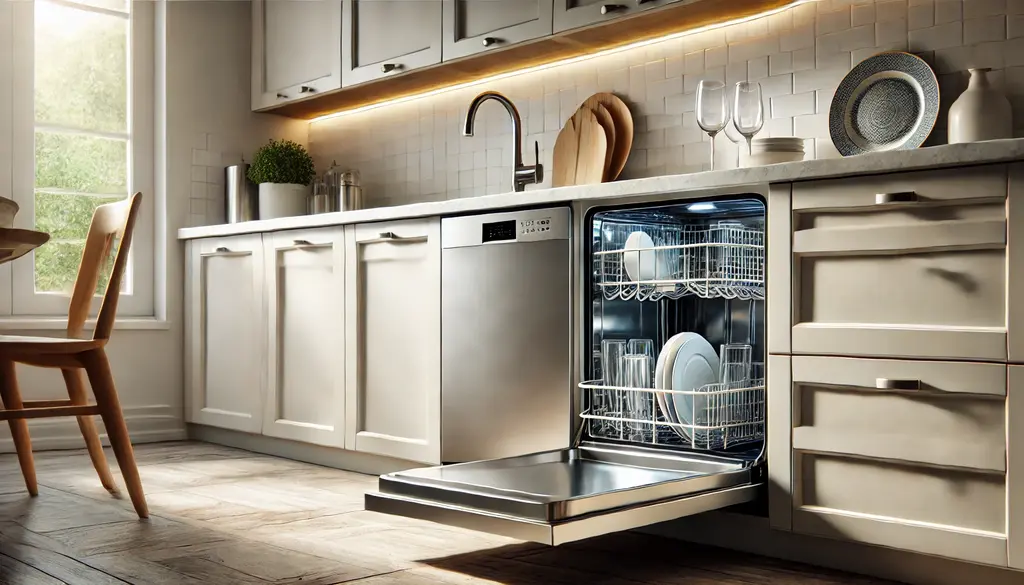If your dishwasher leaves you with wet plates, it may be time for an upgrade. Loud rattling is another warning sign. Long cycles that never seem to end also point to poor performance.
The real challenge is knowing what matters when you shop. This guide explains the essentials. We’ll cover capacity, noise ratings, and smart features. With these tips, you can find the best dishwasher that fits your needs perfectly.
What You Need at a Glance
Pick a built-in dishwasher with 12–16 place settings. A third rack is helpful for utensils and small bowls. It also makes more space in the main racks. If you have an open-plan kitchen, choose a model rated 44 dBA or lower. For the quietest option, go for 38 dBA. This keeps your space calm and peaceful.
For drying, condensation drying saves energy. If you want quicker and stronger drying, choose heated dry or auto-open doors. Make sure the dishwasher has key wash cycles. Look for Auto (sensor), Quick (1-hour), and Sanitize. These handle daily cleaning and extra hygiene needs.
You might also like this: Choosing the Right Kitchen Appliances
Dishwasher Types
Most homes use a 24″ built-in dishwasher. It fits neatly under the counter. It blends well into the kitchen layout. If space is limited, choose an 18″ compact built-in. It saves room. It still keeps the main functions you need.
Drawer dishwashers give you flexibility. They have pull-out drawers instead of a front-opening door. This makes them easier to load. They are also helpful for people who don’t want to bend. You can run one drawer at a time if you like.
For renters, portable and countertop dishwashers are very useful. Portable units roll on wheels. They connect to a faucet. This is a good option if you don’t have built-in space. Countertop models sit on the kitchen surface. They also use faucet adapters. They are compact and easy to move. They are good for small kitchens or dorms.
If you want a seamless and custom look, go for a panel-ready dishwasher. These let you attach a cabinet front that matches your kitchen. The appliance blends in and stays hidden. ADA-height models are also available. They are shorter. Their controls are easier to reach. They are best for people with mobility needs.
Key Specs That Actually Matter
If you’re planning to buy a new dishwasher for your home, keep the following key specs in mind.
Capacity & Racks
Make sure the dishwasher matches your load needs. Most family homes need 14 to 16 place settings. Look for adjustable tines and a third rack for utensils and small items. These features let you customize the space inside.
Cleaning System
Good models use reliable spray arms and soil sensors. They also have strong filtration systems. Some filters clean themselves. Others need manual cleaning. Choose the style that works best for you.
Drying System
Basic options of drying system are condensation or heated dry. Premium models may add a fan or auto-open doors. Some even use mineral-assist technology to reduce water spots and speed up drying.
Noise (dBA)
Noise is important if your kitchen connects to living areas. Choose models rated 44 dBA or below. A rating this low is considered whisper-quiet. It’s ideal for open-plan homes.
Energy & Water Use
Efficiency saves money and helps the planet. Look for ENERGY STAR certification. Use eco cycles when possible. A rinse-aid feature also improves drying while cutting down on water and energy use.
Build Quality
A stainless steel tub is better than a hybrid or plastic. It lasts longer. It holds heat and improves drying. Strong hinges, coated racks, and durable interior surfaces add more years to your dishwasher.
Cycles & Options
Make sure your dishwasher has key programs like Auto (sensor), Quick, Heavy, Sanitize, Half-load, and Delay. These cycles cover daily cleaning, tough loads, and flexible scheduling.
Smart Features
Modern dishwashers include smart tech. You may get Wi-Fi alerts, remote start, or diagnostics. Some even work with voice assistants or Matter systems. These features add convenience and control.
Reliability & Warranty
Look for a clear parts-and-labor warranty. Also check that the brand has a strong service network. This ensures help is available when you need it.
5 Best Dishwasher Brands You Can Rely On
1. Bosch
Bosch is known for whisper-quiet dishwashers. Many are rated at 44 dBA or lower. Some models even reach 38 dBA, which is ideal for open-plan homes.
Bosch uses stainless-steel tubs, flexible third racks, and advanced drying tech like CrystalDry. These features are designed for long-term use. Many Bosch dishwashers are expected to last 10+ years. Bosch also has strong parts availability and repair networks. This makes upkeep easier.
2. Miele
Miele focuses on durability and precision. Many models are built to last up to 20 years. They often include stainless interiors, AutoOpen drying, and AutoDos detergent systems.
Their service rate is a little higher than Bosch. But ongoing improvements help keep them reliable. Users also like their well-designed racks. These allow for greater loading capacity. The elegant build quality is another highlight.
3. KitchenAid
KitchenAid is backed by Whirlpool. The brand offers a mix of performance and thoughtful design. Key features include ProWash cycles, soil sensors, and flexible tines. These adapt to different load types.
KitchenAid is known for its strong cleaning power. Its versatile layouts make it easy to use. It’s a great option for people who want deep cleaning with simple controls.
4. Whirlpool (Including Maytag)
Whirlpool Corp owns Whirlpool and Maytag. These brands are dependable and budget-friendly. Models often have easy controls, soil-sensing cycles, and ENERGY STAR certification.
Many users note that Whirlpool and Maytag are easy to repair. Parts are affordable. Maintenance is simple. In many cases, owners can even replace parts themselves.
5. GE Appliances
GE Appliances is now owned by Haier. Their dishwashers are known for smart features like Wi-Fi control. They also offer versatile styling in the GE Profile and Café lines. Models include unique options like bottle jets and ADA-friendly designs. These features bring creative solutions. At the same time, GE provides reliable performance at mid-range prices.
Fit & Installation Checklist
Measure the cabinet’s width, height, and depth. Check the door swing clearance. Also check the toe-kick space. These details matter if you want a flush and clean look.
Confirm the electrical, water, and drain requirements. You will need a 120V grounded circuit. You also need a hot-water supply line. Make sure a drain connection is available. Use a high-loop or air gap to prevent backflow.
If you choose a panel-ready model, you must attach a custom cabinet front. Adjust the feet to level the dishwasher. Secure it with anti-tip brackets or anchoring brackets. This keeps the unit stable and safe.
Water Quality, Detergent & Drying Aids
If your home has hard water, dishes may show spots or cloudy residue. A built-in water softener can help. An external softening system also works well. You can also add dishwasher salt or white vinegar in a hot cycle to prevent mineral buildup.
When it comes to detergents, pods or tablets are bars ahead in convenience and cleaning power—especially they often include rinse agents. Still, traditional powder detergent deserves its place, particularly if you need to adjust dosing or reduce plastic waste.
Always use a rinse aid. It makes water sheets off dishes. This prevents spots, speeds up drying and leaves dishes sparkling clean.
Maintenance to Keep Performance High
Clean your dishwasher’s filter once a month. This prevents clogs. It also keeps washes efficient. Rinse the spray arm to remove debris. This helps maintain full water flow.
Wipe the door gasket regularly. This keeps the seal tight. It also helps prevent leaks. Run a dishwasher cleaner cycle. You can use a tablet, vinegar, or citric acid to remove residue and buildup.
Always keep the rinse aid filled. Follow correct loading patterns. These steps improve drying and keep performance high.
FAQs about the Best Dishwasher for your Kitchen
What dBA is “quiet” for a dishwasher?
Anything 44 dBA or lower is considered quiet. Models around 38 dBA are almost silent. They are ideal for open kitchens or small apartments. The lower the number, the less background noise you hear. This matters when watching TV, working, or sharing a meal.
Is a stainless tub worth it over plastic?
Yes, in most cases. A stainless tub lasts longer. It resists stains. It also holds heat better, which improves drying. Plastic tubs cost less. But they can trap odors and wear out faster. If your budget allows, stainless steel is the better long-term choice. It gives durability and a cleaner finish.
Condensation vs. heated dry—what’s better?
Both options have benefits. Condensation drying is more energy-efficient. It is also gentler on plastics. Heated dry is quicker. It delivers consistent drying results. Choose condensation if you want efficiency. Choose heated dry if you value speed. Some dishwashers now combine both methods.
Do smart features really help?
Yes, they can help. Wi-Fi and app controls show you the cycle status. You can start loads remotely. You can also get maintenance alerts. Some dishwashers even run self-diagnostics. These features are not essential. But they add convenience for busy households. They also track energy use. They make sure you never forget a load.
24″ vs. 18″—which size should I choose?
A 24-inch dishwasher holds 14–16 place settings. It is best for families or frequent cooks. An 18-inch model holds 8–10 place settings. It works well for couples, apartments, or small kitchens. If you have the space, choose 24″ for flexibility. If you need compactness, go with 18″.


